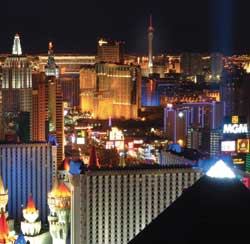While Trump Towers has the name and capital to overcome the hurdle of steep initial investment costs, many projects do not. As a result, their names have been added to a growing list of Las Vegas multifamily properties that have been cancelled or postponed.
One of the most recent of these is The Curve, a mixed-use project slated along I-215 in southwest Las Vegas. It would have featured two 18-story condominium towers with units ranging from 1,100 to 2,025 square feet and prices starting at $385,000 and going up to $1 million. Plans also included approximately 116,000 square feet of retail and restaurant space and 61,000 square feet of office-over-retail space. Construction on phase one was to be complete in late 2006, but a groundbreaking has been postponed after the property fell short of a 75 percent presale mark required for financing.
“Economics, the condo boom, virtually no new apartment construction, and lack of land has made Las Vegas a really high-barrier-to-entry market. It’s almost impossible to do apartment development here now, which makes for a headache on the development side, but is good for owners and sellers,” said Ashish Khatana, managing partner and co-founder of Atherton-Newport, an Irvine, Calif.-based development company. (The firm is involved in select new multifamily construction but its primary business is multifamily acquisition, rehab, and repositioning.) “Of the approximately 2,000 units that are delivered each year in Las Vegas, most are either far outside the metro area or are plausible only because they are being built on land that was acquired a long time ago for a much lower price.”
In terms of future apartment construction, Schmidt foresees an outer ring of development that includes the corridor extending out to Kingman on the Arizona side–spurred in part by the new bridge that will replace the existing bridge over the Hoover Dam–as well as to the northeast and northwest. “This is where garden-style projects can still be constructed and where service workers will still be able to afford to live,” he says.
With all of this activity and growth, there is a rising concern that Las Vegas could become another Southern California, where residents can no longer locate or afford middle- and lower-income housing.
“We’re still a largely service-based community, and we’re continuing to grow in that sector, with the average income being just $44,000. Most service and government workers are employed downtown or on the Strip and would love to live there, but with base condos averaging $300,000 to $500,000, they can’t afford it,” says Schmidt. “Even single-family home prices have doubled to an average $300,000 since the early 2000s. Over a 20-year period, that rivals the rising home prices of Los Angeles.”
It’s a real problem. A 2005 Southern Nevada Workforce Housing study reports that more than 135,000 of the 169,000 new households that are expected to be added to the county by 2010 won’t be able to afford the local median-priced home. And while the county does have 1,207 acres of Bureau of Land Management land reserved for affordable housing, that land supports only 18,000 units, which falls well short of demand.
In hopes of slowing this trend, Las Vegas is moving to develop affordable housing on multiple fronts. Most recently the city purchased Monterey Villas, an 80-unit apartment complex at Tam Drive near Sahara Avenue and bordered by I-15, for $5 million. Rehab costs may reach as much as $1 million, with plans to open in early 2007. Rents would be set at a high of $701 per month for a single-family unit.
